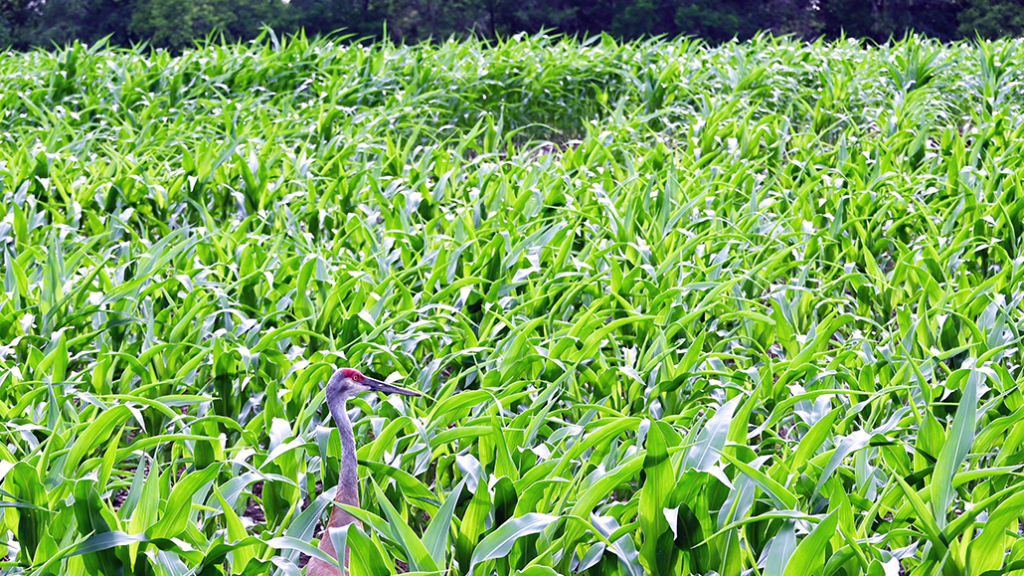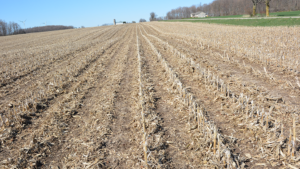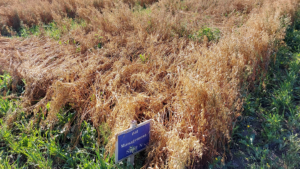Sandhill cranes
ONTARIO FARMS HIT HARD WITH CROP DAMAGE

WILDLIFE DAMAGE COSTS crop farmers an estimated $41 million each year. In some parts of Ontario, the number one culprit is the sandhill crane — and the problem continues to grow. As the population and range of the birds expand across the province, so does the impact on Ontario’s farmers.
A GROWING PROBLEM
“Most Ontario farmers aren’t even aware of sandhill cranes,” says Christopher Sharp, population management biologist for the Canadian Wildlife Service (CWS), Environment and Climate Change Canada. But in areas that are along their migratory path — primarily northern and central Ontario — sandhill cranes can cause significant crop losses, particularly in agricultural areas on the fringes of the boreal forest. Nearly extinct at the turn of the 20th century, the sandhill crane population now stands at more than 14,000.
The potential damage to crops depends on the time of the year and the stage of the crop in relation to the birds’ migration. In the spring, sandhill cranes can cause significant damage to corn by digging up and eating the seeds, with farmers reporting having to replant entire fields of corn. In the late summer and fall, cereal crops and potatoes are most at risk. “Farmers have reported losing an entire crop of barley just days before harvest,” says Sharp, noting that the bulk of the loss is due to trampling rather than being consumed by the cranes.
“The losses can be quite dramatic,” says Birgit Martin, who farms on Manitoulin Island. This spring, she had to replant approximately 25 per cent of her corn acres due to sandhill crane damage. “When the corn is first emerging, the cranes go plant by plant, pulling out the plant and eating the seed.”
“Crop insurance pays for the replant, but then the crop is three weeks late, and there is a cost in terms of the time you spend replanting.”
Sharp says that there are some mitigation strategies that farmers can try to help prevent crop losses, including hazing or scaring (without using aircraft or a firearm, which requires a permit), modifying farm practices such as changing crops (e.g. substituting barley with oats or wheat), delaying planting to avoid the cranes’ migration, or planting lure crops — potato farmers, for example, have had success growing barley as a cover crop, which is more desirable for the cranes, to prevent damage to their potato fields.
A migratory birds damage or danger permit can be obtained from CWS, which allows farmers to use firearms to ‘kill to scare.’ Martin has used this method on her farm but says it’s not overly effective. “It’s time-consuming,” she says.
A POSSIBLE SOLUTION
In contrast to the 2022 season, when Martin had to replant corn, she says they had virtually no losses in 2021. That’s because her farm took part in a trial of a seed treatment called Avipel — an effective, non-lethal, non-toxic seed treatment that deters cranes and other birds from eating the corn seed. Avipel has been used successfully in the U.S. for more than 10 years. “It’s a win-win,” says Martin. “Avipel lets us farm in concert with wildlife.” She says they had no losses, even on fields that were adjacent to a bird sanctuary.
Chatham Biotech Ltd., based in New Brunswick, has submitted an application to the Pest Management Regulatory Agency to get Avipel approved for use in Canada. Martin was part of Chatham Biotech’s trial to replicate U.S. data in Canada.
“Farmers in Canada are at a competitive disadvantage,” says Eric Smith, research coordinator for Chatham Biotech. “Avipel is used by farmers in more than 40 U.S. states… with the price of fertilizer and inputs, farmers can’t afford to lose profits due to the damage caused by cranes.”
ONGOING RESEARCH
Sharp is part of an ongoing CWS project to collect movement data of sandhill cranes and the subsequent impact on agricultural land. The data collected will be used to identify risk factors for damage and inform mitigation strategies, including answering questions like what types of fields and crops are most at risk; what factors influence where damage is most likely to occur within fields; and how farm practices impact crane movements.
In 2019, they captured 70 sandhill cranes and fitted 24 with GPS transmitters, focusing on the Abitibi region of Quebec and Timiskaming in Ontario. By 2021, the number of transmitters had increased to just over 100 cranes in and around New Liskeard, Earlton, Sudbury, Sault St. Marie, and Manitoulin Island. Now in the last year of the study, graduate students at the University of Waterloo are analyzing the data from the transmitters to come up with best practices for damage mitigation.
In the meantime, Sharp says that the prevalence of sandhill cranes and the accompanying crop damage that occurs will only increase. Farmers that start to see an impact on their farms due to the expanded migratory pattern and growing population of sandhill cranes are encouraged to reach out to CWS to discuss the best mitigation strategies for their particular situation.
“Sandhill cranes aren’t going anywhere,” he says. “Ultimately, we’re trying to provide tools for farmers, so they aren’t detrimental to their livelihood.” •

























